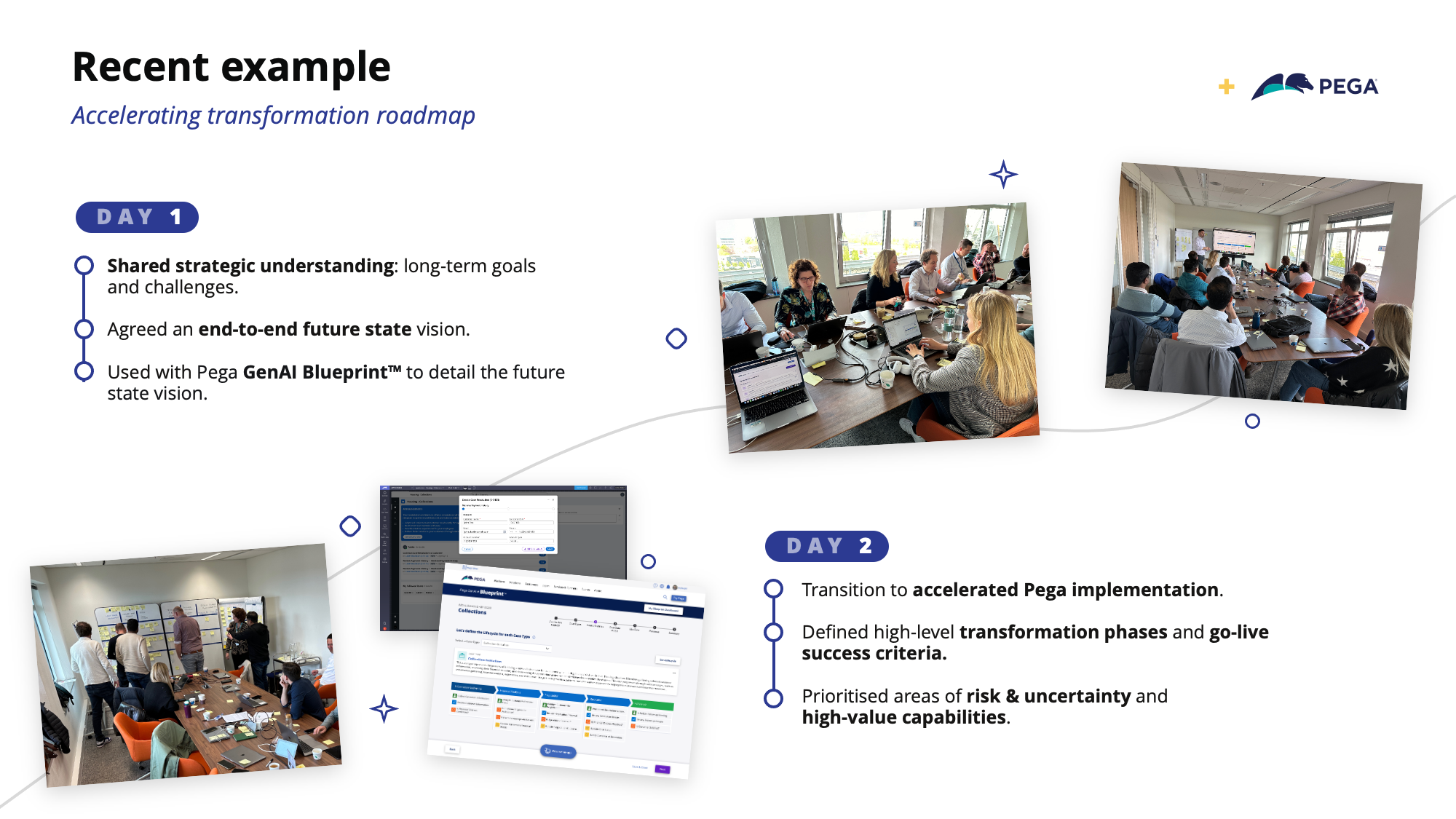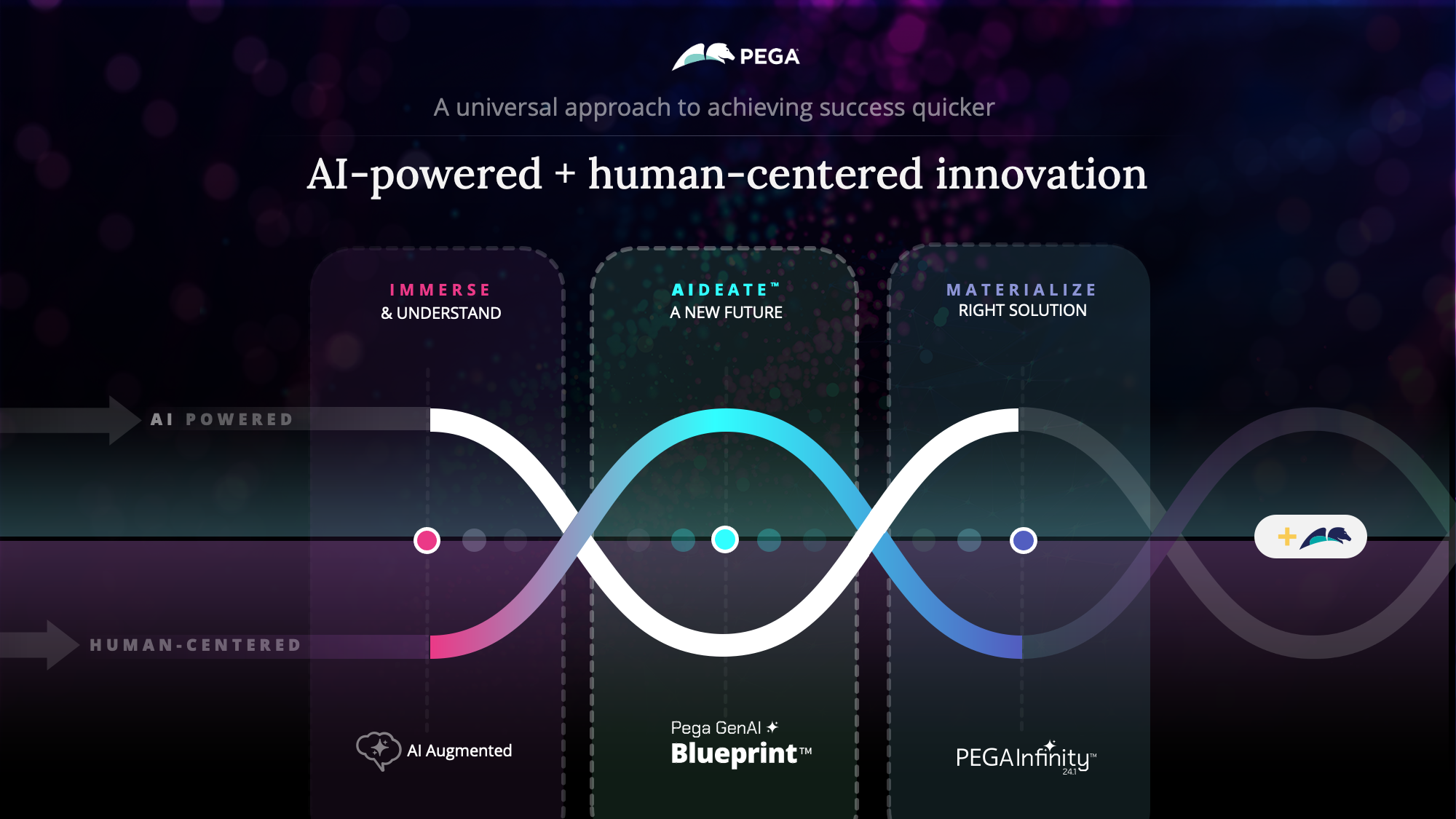Transforming Business & IT Collaboration: The Power of Pega Blueprint and Generative AI
In today's fast-paced digital landscape, the alignment between business and IT teams is more critical than ever. Traditional methods such as design thinking have long been instrumental in bridging gaps and fostering collaboration. However, with the advent of Generative AI and advanced tools like Pega Blueprint, organizations now have the opportunity to enhance these traditional approaches, accelerating innovation and improving outcomes.
Traditional Approaches to Collaboration: The Role of Design Thinking
Design thinking has been a cornerstone in business and IT collaboration, offering a structured yet flexible approach to problem-solving. By emphasizing empathy, ideation, and prototyping, it encourages cross-functional teams to deeply understand user needs and co-create solutions. Workshops based on design thinking principles often involve collaborative brainstorming sessions, where business and IT stakeholders come together to map out user journeys, identify pain points, and explore potential innovations.
While effective, these traditional workshops can sometimes be hindered by the complexities of translating business needs into transformation strategy and technology solutions. This gap can lead to miscommunications, delays, and a lack of alignment between business goals and IT execution.
The Power of Generative AI in Collaboration
Generative AI introduces a transformative element to the collaboration process. By leveraging advanced machine learning models and industry knowledge, Generative AI can quickly analyze vast amounts of data, generate insights, and even propose solutions – instantly.

Throughout the planning process, generative AI can act as another (very knowledgeable) teammate, augmenting traditional business and IT collaboration to enable:
- Injecting insights and best practices into complex processes: AI tools can sift through historical data, industry knowledge, and market trends to offer deeper insights, helping teams make data-driven decisions.
- Defining starting points for simple processes and exceptions: AI can quickly set a template for standard processes, enabling teams to focus on high-value workflows.
- Faster prototyping: Generative AI can quickly create multiple solution alternatives based on desired business outcomes, allowing teams to explore a broader range of solutions in less time.
- Real-time feedback: AI can simulate different scenarios and predict outcomes, providing instant feedback on the viability and potential impact of proposed solutions.
These capabilities not only streamline the collaboration process but also enhance it by bringing data-driven insights and automation into the mix.
Accelerating Collaboration with Pega GenAI Blueprint: Idea to Demo in Hours
Pega GenAI Blueprint enables business and IT teams to collaborate on end-to-end workflow designs fast, aided by generative AI. And when the Blueprint is completed, it allows users to take those workflow designs into new cloud automations instantly.
So, what’s the best way to bring business, IT, and generative AI together to work on a Blueprint? Whether in person or virtual, starting projects with a Blueprint workshop is a great way to get all stakeholders aligned from the get-go and to quickly go from idea to solution prototype.
At a high level, the recipe for a successful Blueprint workshop includes:
- Start with the business problems and goals: Spend time defining the business problem space, which will inform your prompts throughout Blueprint. Discuss and refine:
- The business goals you are looking to achieve.
- The challenges you need to overcome.
- Where your vision starts and ends to frame the scope.
- Write a starting prompt and start your Blueprint: Bring your goals, problems, and scope together as a starting point for your Blueprint.
- Pro tip: Generative AI tools can help further refine and improve your initial thoughts and help you write a prompt for Blueprint.
- Review the Blueprint once: Level-set everyone with the generative AI suggested starting point, which will unlock some ideas of where to focus throughout the workshop.
- Walk through every component in the Blueprint:
- Case types: Curate the list of business processes.
- Ask the team about the overall business process. What are the components of the end-to-end process within that function?
- Explain a bit about how Pega’s case management works, such as how each workflow gets set up with auditing, SLA, routing, prioritization, etc. Capture any detailed business needs as you go.
- Case lifecycles: Refine each workflow lifecycle.
- Ask the team about the work. What are the stages and steps of each workflow?
- Explain Pega’s automation capabilities, such as how RPA, AI, decisioning, business rules, integrations, and more can come together within each workflow to drive any type of work to completion.
- Data: Define the data, fields, and systems.
- Ask about the data and systems the team knows about. What are the different systems you’ll need data from across these workflows?
- Explain Pega’s Live Data layer, such as how it virtualizes and abstracts data from back-end systems, and how each data object can intelligently connect to one or multiple systems of record (SOR).
- Personas: Detail the roles that need access to these workflows.
- Ask about who engages with these workflows. Who needs experiences to create, do, and report on work across these customer and business journeys?
- Explain Pega’s Center-out business architecture, such as how all workflows can be embedded across experiences for each persona, deploying workflows seamlessly to operations, customer service, and self-service.
- Case types: Curate the list of business processes.
- Turn Blueprint into a working application: Import your Blueprint into Pega to generate a new application with your workflows, data, and personas. Run through the application to get a sense of how this will come to life for your users and test it with a few.
- Next steps: Blueprint sets a solid foundation for the project vision and application design, and also helps guide next-level discovery and definition. Have a conversation with your team about the biggest unknowns within and beyond the Blueprint. Go through the Blueprint and highlight the areas which need further elaboration, and leverage targeted deep dives and operational walkthroughs to capture details for those areas, to build out a more comprehensive vision.
Case Study: A Cooperative Bank's Digital Transformation
A cooperative bank sought to accelerate its digital transformation roadmap, facing challenges in aligning its business vision with IT capabilities. The bank's leadership aimed to empower IT teams to deliver incrementally and establish a continuous improvement loop, but there was a significant disconnect between strategic goals and execution. Initially, the program was expected to take several years to deliver.

However, by integrating Pega GenAI Blueprint and Generative AI, the bank dramatically accelerated its timeline. In a series of two half-day collaborative workshops, business and IT teams used Pega Blueprint to map out the digital transformation strategy. Generative AI analyzed the existing vision and the current landscape, providing valuable insights that guided the team's decision-making.
Within just 60 days, the teams delivered the first solution, far surpassing the original timeline. This rapid deployment was achieved through Pega Blueprint's visual modeling and AI-driven recommendations, which facilitated clear communication and alignment between business and IT. The cooperative bank was able to quickly implement a customer-centric solution that addressed key pain points, setting the stage for ongoing improvements and innovation.
Conclusion
The integration of Generative AI and Blueprint into traditional collaboration frameworks like design thinking marks a transformative shift in how organizations approach digital transformation. These advanced tools not only accelerate project timelines but also ensure that solutions are data-driven and aligned with business goals. As organizations continue to navigate the complexities of digital transformation, the adoption of these advanced tools is crucial in maintaining agility, innovation, and alignment across business and IT teams.
For businesses aiming to enhance their collaboration between business and IT, adopting platforms like Pega Blueprint and leveraging the power of Generative AI can significantly shorten development cycles and improve project outcomes. The future of digital transformation is dynamic and collaborative, driven by the seamless integration of business vision and technological execution. It promises to be more dynamic, data-driven, and efficient than ever before.

To further explore how AI can augment your innovation processes, consider engaging with Pega Client Innovation. At Pega, we have reimagined how AI enhances the innovation journey and transformed the methods we use to help our customers and partners innovate. The future is about integrating the best of human-centered and AI-powered approaches to drive meaningful and impactful change. For more information, visit Pega Catalyst.
Thanks to Maike Strudthoff, Adam Pink, Matt Healy, and Baruch Sachs for co-writing and reviewing drafts of this article.
